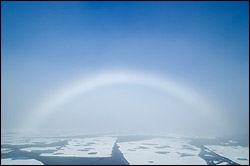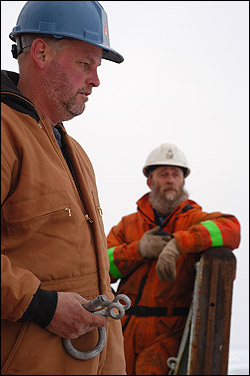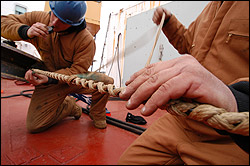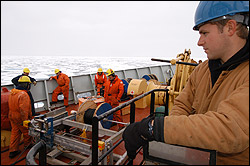Please note: You are viewing
the unstyled version of this website. Either your browser does not support CSS
(cascading style sheets) or it has been disabled. Skip
navigation.
Chris LinderAugust 17, 2005
The light streaming through my porthole was dull and flat when I woke up this morning, but the fog had lifted. Leaden clouds covered the sky, but the air was dry and warm. Immediately after breakfast the mooring group began deployment of Mooring B, the second deep subsurface mooring of the Beaufort Gyre Observing System. Watching the crew in action, it was apparent that this was becoming routine. Everyone anticipated the action; I don't think I heard John's whistle for attention even once today. Just after lunchtime the mooring was in position and the top sphere was gingerly lowered to the dark water below. Once John confirmed that we were in position, he pulled the quick release and the mooring shot downwards. Unlike the Camp Smiley moorings, it will be year before we will see any plots of this data. Our bow is now pointed eastwards. On our way to the next CTD station we passed through patches of fresh rubbery "grease ice." The sound of the hull crushing the thin ice is like the tinkling of broken glass. Then, boom boooom booooom takes over--it's back into the multi-year floes. Tomorrow we will be searching for another solid multi-year floe for the second ice camp. Let's hope the fogbows are left behind, because good visibility is critical when scouting for floes in the helicopter. Last updated: October 7, 2019 | ||||||||||||||||||||||
Copyright ©2007 Woods Hole Oceanographic Institution, All Rights Reserved, Privacy Policy. | ||||||||||||||||||||||






